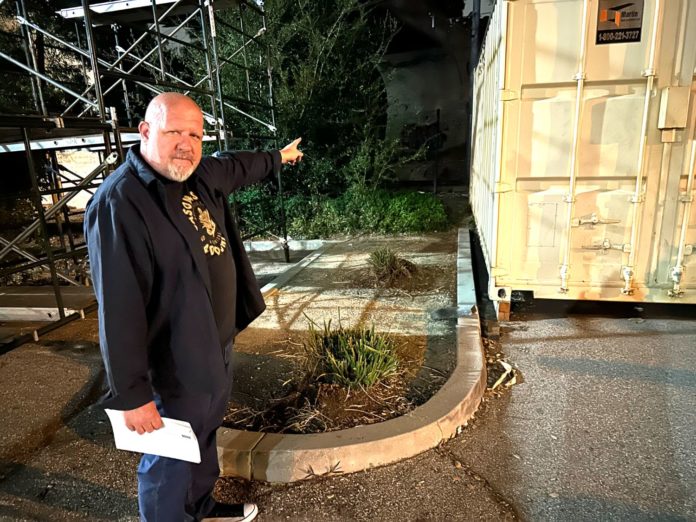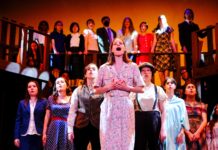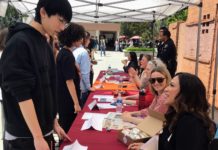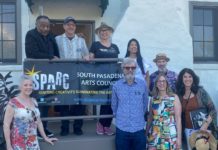
Working in the outdoor elements, where cold, harsh winters can play havoc, weighs heavily on efforts to build a permanent indoor facility housing South Pasadena’s float that takes part in the Rose Parade.
Ed Donnelly, chair of the South Pasadena Tournament of Roses Committee (SPTOR), hopes the day comes when a giant tent –open on one side to the elements – is replaced by a structure with four walls, providing simple amenities like heat and water.
“Our current situation is not ideal,” insisted Donnelly, talking about efforts to improve the float building experience for those who lend a hand building and covering it in natural flowers and flowers before it rolls down Pasadena’s Colorado Boulevard for its annual 5.5-mile journey to welcome in a new year. “It’s cold, it’s wet and far from perfect.”
Added Donnelly, laughing: “We had a hurricane this year! We were afraid the tent was going to blow away. It’s really simple, we can do better for those who volunteer to work on the float.”
He’s mindful that the city has been involved with the Rose Parade since 1893, and building floats, the self-built variety with total volunteer support, going back to 1911.
“Because we have this 100-year tradition, we want to make sure we can sustain it,” explained Donnelly. “Over the years, we’ve been working under a temporary tent. When it rains, our volunteers are standing in water as it flows under the tent. It’s fine for now but it’s not sustainable for the future.”
Further, Donnelly insists, a permanent home for the float would not only keep workers dry, but it will become a safe haven to store flowers, materials, and other supplies. In addition, the float chassis, including its engine, will be protected from the wet weather.
If his dream does come true, Donnelly said the long-term goal is to have “a headquarters where we also have a museum to carry the float’s traditions, a place to showcase historical photographs, pin collections and other memorabilia over the years. It will strengthen our ability to really become a community gathering point. That’s something that really excites me.”
A permanent location in the same parking area would also save the organization more than $20,000 in rental fees it pays to erect the tent for roughly the last four months of the year – August through December –when float construction is the heaviest.
A desire for a permanent site is nothing new. Its original vision was put into motion about 20 years ago by the late Ted Shaw, a former South Pasadena mayor and president of SPTOR, who worked tirelessly with city officials to come up with a resolution between the two parties before his death in February 2020.
“A lot of the legacy of what we’re hoping for regarding this new building is because of Ted’s hard work and generosity,” said Donnelly. “His vision for the building was much like it was for a lot of the things he did when contributing to the community. He wanted to bring everybody together and celebrate what makes South Pasadena special.”
Donnelly quickly added: “And he wanted to make sure we were looking toward the future. This is an example of that, having a permanent home for a longtime tradition here in the city. Now it’s up to us to see if we can actually make that happen.”
Shaw initially worked with Elizabeth Greene, a descendent of the Greene and Greene architects, to come up with a site plan for the float to be housed. Greene and Greene was a famed architectural firm established from 1870 to 1954 by Charles Sumner Greene and Henry Mather Greene, and their imprint can be found all over South Pasadena.
In recent years, former SPTOR Chair Brant Dunlap, Donnelly and others have teamed up, working together to potentially see Shaw’s dream for an enclosed home for the float come true. The site most talked about is on the same grounds where construction now takes place behind the War Memorial Building in the 400 block of Fair Oaks Avenue. Donnelly believes the ideal space for construction is next to the historic Oaklawn Bridge in the back parking lot area.
If the permanent site becomes a reality, Donnelly says it will further strengthen the float’s importance in the community as a viable entity, and a meaningful piece of history that is going to be around for many decades to come. “We can’t sustain a tent,” he stressed. “We can sustain a building.”
Donnelly said talks are underway between the SPTOR and city officials as he keeps his hopes alive for the future permanent building. “We want to see what we need to do to make it happen,” he said.















.png)









